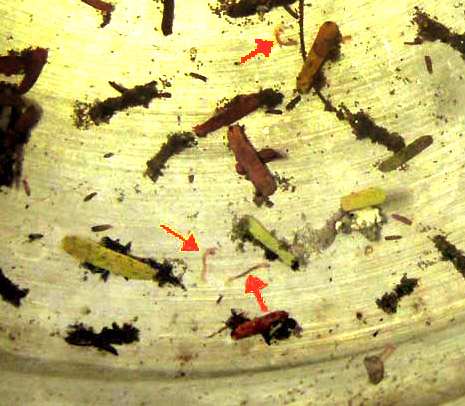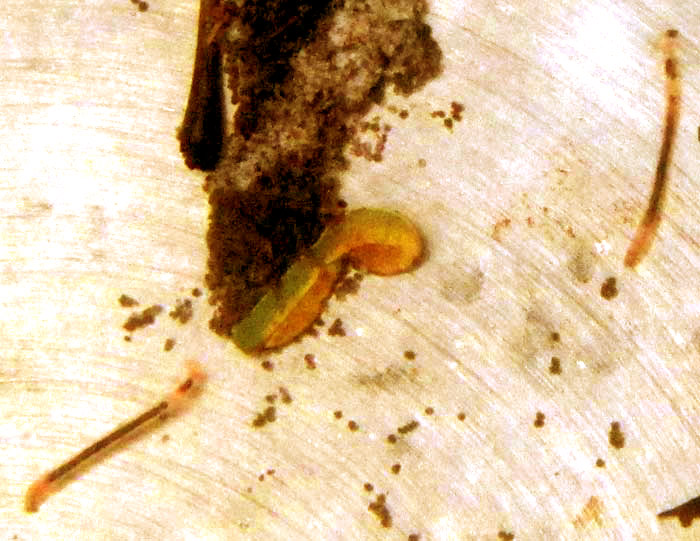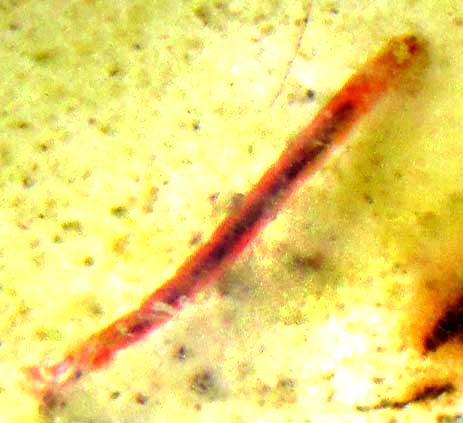Excerpts from Jim Conrad's
Naturalist Newsletter
Entry issued on October 29, 2019, from the forest just west of Tepakán; elev. ~9m (~30 ft), N21.053°, W89.052°; north-central Yucatán state, MÉXICO
BLOODWORMS
After rainwater had sat for a few days in my aluminum pot, I looked inside and saw the bottom covered with submerged, ¼-in-long (5mm) leaflets from the acacia-tree above it, each leaflet surrounded by tiny brown particles. Studying the situation, eventually I saw tiny, almost transparent, worm-like creatures scattered among the leaves, sometimes one of them beneath a leaflet reaching out and apparently gathering more particles for placing around themselves. Yellow arrows in the picture below point to three of the creatures, which I assumed to be aquatic insect larvae.

Below, a close-up of two of the larvae, in the top-right and bottom-left of the picture, shows that the larva body is fairly transparent, but containing dark zones, which I guess might be food and/or bodily organs. Also, one end bears a small, rounded head while the opposite end hooks and may bear something like "feet."

One day a larger larva turned up, apparently with the same structure, but red, shown below:

With help from the "Field Guide to Aquatic Invertebrates", freely downloadable in PDF format on the Internet, I identified the larvae as members of the True Fly Order, the Diptera, and the family CHIRONOMIDAE, whose adults are known as non-biting midges, lake flies, chironomids, and by other names. The adults resemble mosquitoes, except that they lack the mosquitoes' long, slender, bloodsucking mouthparts, and lack scales on their wings.
Probably well over 10,000 species of Chironomidae occur worldwide, so I have little hope of identifying these larvae to species or even genus level. The Wikipedia entry for the Chironomidae describes the species as "found in almost any aquatic or semiaquatic habitat, including treeholes, bromeliads, rotting vegetation, soil, and in sewage and artificial containers. " They're particularly successful in polluted water and water with extremely low oxygen levels. My collected rainwater was off the hut's tin roof, where iguanas and birds leave a good bit of poop.
The red color of our later-stage larva is caused by its body containing a "hemoglobin analog." A chemical analog is a compound with a molecular structure closely similar to that of another, in this case hemoglobin. Hemoglobin is a red protein that carries oxygen in the blood, and this is thought to be one reason why bloodworms can survive in water containing very little oxygen. Also, the bloodworms I watched swam by very vigorously curving their bodies into Cs and backward Cs maybe two or three times a second. A larva that appeared to be feeding on something adhering to the aluminum pan's bottom, possibly algae, constantly undulated its body. Such movements constantly would be bringing the larva's body into contact with water bearing more oxygen than that around a stationary body.
Because of their abundance, both adult and larval Chironomidae serve as an important food source for many kinds of animals.